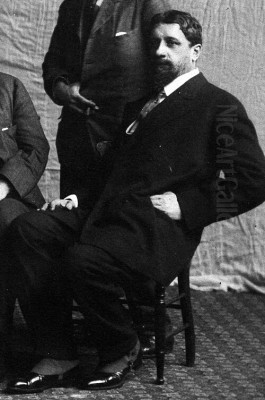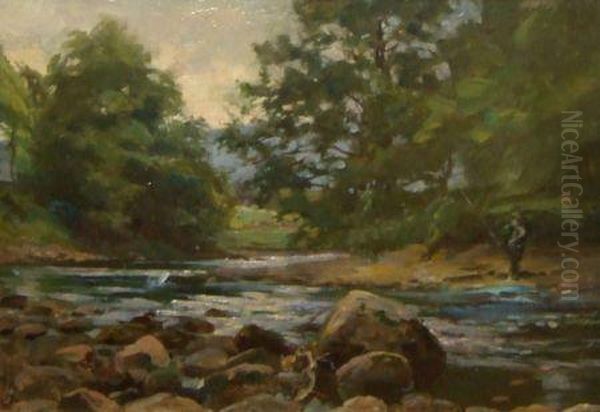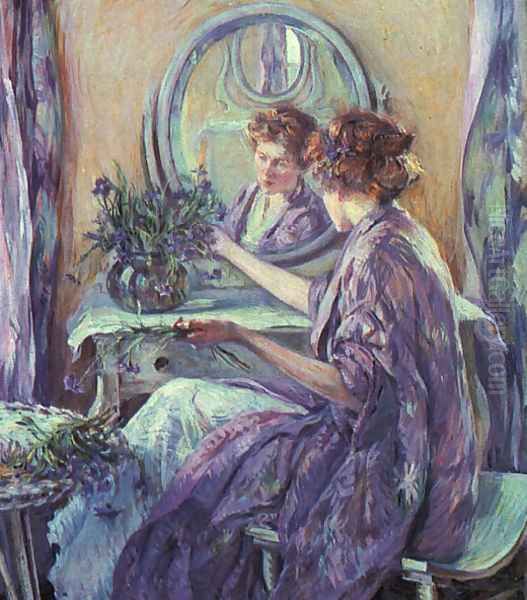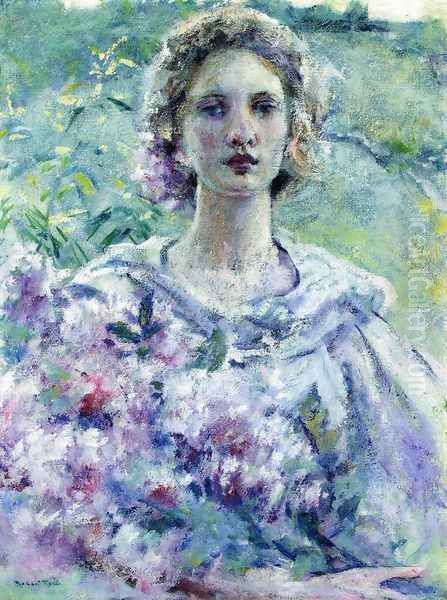
Robert Lewis Reid (1862–1929) stands as a significant figure in American art history, recognized primarily for his contributions as both an Impressionist painter and a prolific muralist. Born in Stockbridge, Massachusetts, Reid emerged during a vibrant period of artistic development in the United States, ultimately becoming a key proponent of Impressionism on American soil and a master of large-scale decorative works that adorned prominent public buildings. His career reflects the transatlantic artistic exchanges of the late 19th and early 20th centuries, blending European techniques with a distinctly American sensibility.
Early Life and Artistic Formation
Robert Reid's artistic journey began in his native New England. He received his initial formal training at the School of the Museum of Fine Arts, Boston, studying under Otto Grundmann. During this period, he also served as an assistant instructor, indicating an early aptitude for his craft. Seeking broader horizons, Reid moved to New York City and enrolled briefly at the Art Students League, though records suggest he found the curriculum less than satisfying at the time. This restlessness and ambition soon led him across the Atlantic.
Like many aspiring American artists of his generation, Reid traveled to Paris, the undisputed center of the art world in the late 19th century. From 1885, he immersed himself in the rigorous academic training offered at the Académie Julian, a popular destination for international students. There, he studied under the tutelage of respected Salon painters Gustave Boulanger and Jules Lefebvre. This academic grounding provided him with technical proficiency in drawing and composition, forming a solid foundation upon which his later, more experimental style would be built. His time in Europe, including travels beyond Paris, exposed him directly to burgeoning modern art movements, most notably French Impressionism.
Embracing Impressionism: Light, Color, and The Ten

Upon his return to the United States around 1889, Reid's artistic style underwent a significant transformation. Deeply influenced by his experiences in Europe and the work of French Impressionists like Claude Monet and Pierre-Auguste Renoir, he began to move away from purely academic conventions. He embraced the Impressionist emphasis on capturing the fleeting effects of light and atmosphere, employing a brighter palette and looser brushwork. His easel paintings from this period frequently depict idealized young women, often set outdoors amidst vibrant floral settings or bathed in dappled sunlight.
These works are characterized by their decorative quality, sensitivity to color harmony, and a focus on beauty and grace. Paintings such as The Arrangement, In Woods, and Mother and Daughter exemplify this phase of his career, showcasing his ability to render figures and nature with an appealing luminosity and delicate touch. Reid developed a reputation for these charming, aesthetically pleasing compositions that celebrated feminine beauty intertwined with the natural world.
Reid's commitment to Impressionism extended beyond his individual practice. In 1897, he became a founding member of the influential group known as the "Ten American Painters," or simply "The Ten." This collective, which included fellow artists Childe Hassam, J. Alden Weir, John Henry Twachtman, Willard Metcalf, Frank W. Benson, Edmund C. Tarbell, Thomas W. Dewing, Joseph De Camp, and Edward Simmons (later replaced by William Merritt Chase after Twachtman's death), seceded from the larger Society of American Artists (SAA). They felt the SAA's large annual exhibitions had become overcrowded and presented works in a manner unfavorable to their more intimate, stylistically cohesive Impressionist paintings. The Ten organized their own smaller, curated exhibitions, promoting American Impressionism and asserting their artistic independence. Reid remained an active participant in their exhibitions for two decades.
The Muralist: Grand Scale Decoration
While continuing to produce easel paintings, Robert Reid increasingly turned his attention to mural painting, becoming one of the leading figures in the American Renaissance mural movement. This shift coincided with a period of extensive public building construction in the United States, often designed in the Beaux-Arts style, which demanded integrated decorative schemes. Reid's talent for decorative composition and his vibrant palette proved highly suitable for large-scale wall paintings.
His first major mural commission came with the World's Columbian Exposition held in Chicago in 1893. He was among several prominent artists selected to decorate the domes and pavilions of the fair's magnificent, albeit temporary, "White City." Reid contributed murals to the Liberal Arts Building, working alongside artists such as Edwin H. Blashfield, Kenyon Cox, Gari Melchers, Walter MacEwen, and Carroll Beckwith. This project significantly raised his profile as a muralist.

Following the success in Chicago, Reid secured numerous prestigious commissions. One of his most celebrated achievements is the series of murals he painted for the Thomas Jefferson Building of the Library of Congress in Washington, D.C., completed around 1896-1897. His five lunettes in the North Corridor of the Great Hall depict the "Five Senses," rendered as graceful female figures in allegorical poses, demonstrating his characteristic decorative flair and mastery of integrating painting with architecture.
Other significant mural projects followed, solidifying his reputation. He created decorations for the Massachusetts State House in Boston, the Appellate Division Courthouse of New York State in Manhattan (working alongside members of The Ten and others like Kenyon Cox and H. Siddons Mowbray), and the Fine Arts Pavilion (now the Palace of Fine Arts) for the Panama-Pacific International Exposition (PPIE) in San Francisco in 1915. His murals often featured allegorical themes, idealized figures (predominantly female), and a continued exploration of light and color, adapted to the demands of monumental scale.
Artistic Style and Recurring Themes
Robert Reid's artistic output is marked by a consistent dedication to beauty and decorative effect, whether in his easel paintings or his murals. His Impressionist works are noted for their high-keyed color, often featuring blues, lavenders, greens, and whites, applied with visible, sometimes textured brushstrokes that capture the vibrancy of light. The subject matter frequently revolves around elegant young women, portrayed singly or in small groups, often engaged in quiet contemplation or leisure activities amidst flowers or sunlit landscapes. There is a distinct refinement and idealism in his portrayal of femininity.
His mural work, while necessarily adapting to architectural contexts and often conveying allegorical or historical themes, retains this decorative sensibility. The figures are typically idealized and gracefully composed, integrated into harmonious color schemes designed to complement the surrounding space. Even on a grand scale, his sensitivity to light effects remained evident. Some critics noted a similarity in the decorative quality and idealized figures to the work of British Pre-Raphaelite painter Edward Burne-Jones, although Reid's technique and palette remained firmly rooted in Impressionism.
Beyond oil painting and murals, Reid also occasionally worked with stained glass, further demonstrating his versatility and interest in decorative arts. Across all mediums, his work consistently reflects a pursuit of aesthetic harmony, technical skill, and an optimistic, often idyllic, vision.
Teaching, Recognition, and Awards

Parallel to his painting career, Robert Reid contributed to art education. He served as an instructor at the Cooper Union School of Design for Women and later at the Art Students League in New York. His earlier role as an assistant instructor at the Boston Museum School also points to his engagement with teaching early in his career. While specific details about his pedagogical methods or notable students are scarce, his positions at these important institutions indicate his standing within the art community.
Reid received significant recognition during his lifetime. He was elected an Associate of the National Academy of Design in 1902 and achieved full Academician status in 1906, signifying his acceptance by the established art institution despite his earlier association with the secessionist group, The Ten. His work garnered numerous awards at major national and international exhibitions. Notably, he won both gold and silver medals at the Paris Exposition Universelle of 1900 and received another gold medal for his contributions to the Panama-Pacific International Exposition in San Francisco in 1915. These accolades confirmed his reputation both at home and abroad.
Later Life and Enduring Legacy
In his later years, Robert Reid's artistic production reportedly slowed due to declining health. He passed away in 1929 at a sanatorium in Clifton Springs, New York, at the age of 67. Despite a relatively shorter period of peak activity compared to some contemporaries, Reid left a considerable mark on American art.
His legacy resides primarily in his dual contribution as a key figure in the second wave of American Impressionism and as a major muralist during the American Renaissance. As a member of The Ten, he helped champion Impressionism and challenge the conservative exhibition practices of the time. His easel paintings, with their characteristic charm and focus on light and feminine beauty, remain appealing examples of the American adaptation of the Impressionist style.
His murals, adorning significant public buildings, represent an important contribution to the nation's architectural heritage and the history of American mural painting. They exemplify the era's ambition to integrate art and architecture and reflect the cultural optimism and classicizing tendencies of the Beaux-Arts period.

Today, Robert Reid's works are held in the collections of major American museums, including the Metropolitan Museum of Art in New York, the Smithsonian American Art Museum and the National Gallery of Art (housing the Corcoran Collection) in Washington, D.C., the Albright-Knox Art Gallery in Buffalo, and the Bowdoin College Museum of Art in Brunswick, Maine, among others. His paintings and murals continue to be studied and appreciated for their technical skill, decorative appeal, and their embodiment of American artistic currents at the turn of the 20th century. He remains an important figure for understanding the development of both Impressionism and mural decoration in the United States.